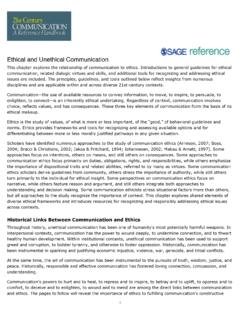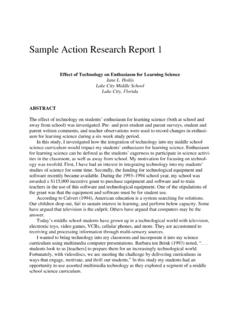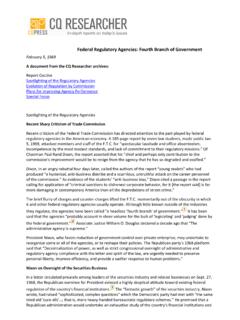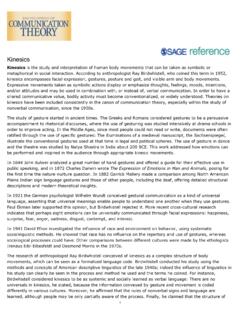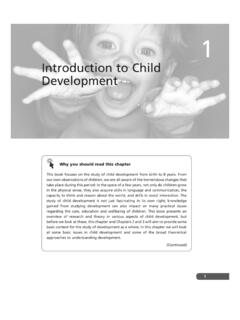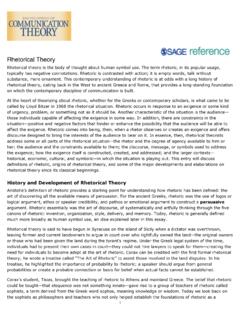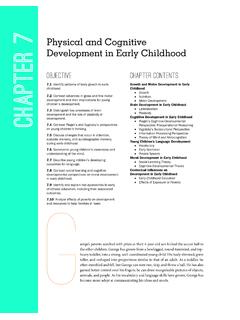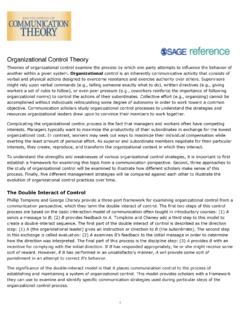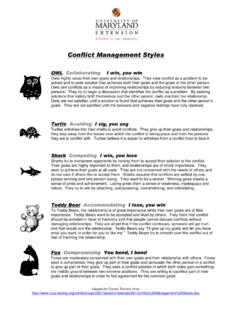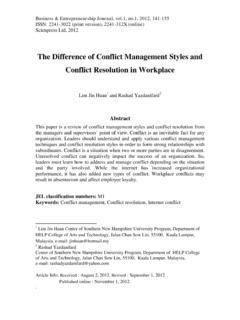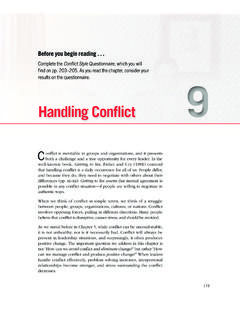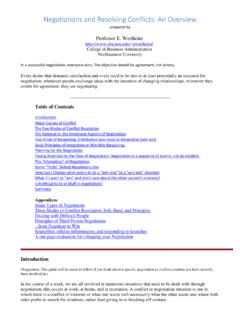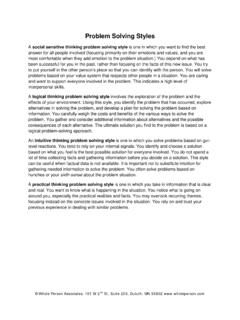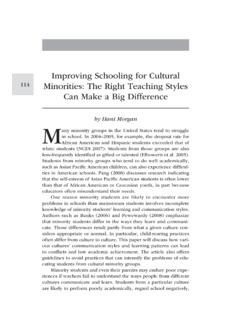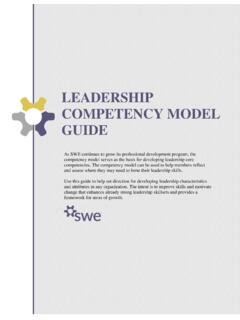Transcription of 10.2 C ONFLICT STYLE QUESTIONNAIRE - SAGE …
1 INTRODUCTION TO LEADERSHIP254 APPLICATION Visit for a downloadable version of this CONFLICT STYLE QUESTIONNAIREP erson A Person B 1. _____|____ I avoid being put on the spot ; I keep conflicts to myself. 2. _____|____ I use my influence to get my ideas accepted. 3. _____|____ I usually try to split the difference in order to resolve an issue. 4. _____|____ I generally try to satisfy the other s needs. 5. _____|____ I try to investigate an issue to find a solution acceptable to both of us. 6. _____|____ I usually avoid open discussion of my differences with the other. 7. _____|____ I use my authority to make a decision in my favor. 8. _____|____ I try to find a middle course to resolve an impasse. 9. _____|____ I usually accommodate the other s _____|____ I try to integrate my ideas with the other s to come up with a decision _____|____ I try to stay away from disagreement with the _____|____ I use my expertise to make a decision that favors _____|____ I propose a middle ground for breaking To identify your conflict style2.
2 To examine how your conflict STYLE varies in different contexts or relationshipsDirections1. Think of two different situations (A and B) where you have a conflict, a disagreement, an argument, or a dis-appointment with someone, such as a roommate or a work associate. Write the name of the person for each situation According to the scale below, fill in your scores for Situation A and Situation B. For each question, you will have two scores. For example, on Question 1 the scoring might look like this: 1. 21 43. Write the name of each person for the two situations here:Person A _____ Person B _____1 never 2 seldom 3 sometimes 4 often 5 always255 Chapter 10 Handling ConflictAPPLICATIONP erson A Person B14. _____|____ I give in to the other s _____|____ I try to work with the other to find solutions that satisfy both our _____|____ I try to keep my disagreement to myself in order to avoid hard _____|____ I generally pursue my side of an _____|____ I negotiate with the other to reach a _____|____ I often go with the other s _____|____ I exchange accurate information with the other so we can solve a problem _____|____ I try to avoid unpleasant exchanges with the _____|____ I sometimes use my power to _____|____ I use give and take so that a compromise can be _____|____ I try to satisfy the other s _____|____ I try to bring all our concerns out in the open so that the issues can be.
3 Adapted from Confirmatory Factor Analysis of the styles of Handling interpersonal Conflict: First-Order Factor Model and Its Invariance Across Groups, by M. A. Rahim and N. R. Magner, 1995, Journal of Applied Psychology, 80(1), 122 132. In W. Wilmot and J. Hocker (2011), interpersonal Conflict (pp. 146 148). Published by the American Psychological : Add up your scores on the following questions:A | BA | BA | BA | BA | B 1. ____|____ 6. ____|____11. ____|____16. ____|____21. ____|____ 2. ____|____ 7. ____|____12. ____|____17. ____|____22. ____|____ 3. ____|____ 8. ____|____13. ____|____18. ____|____23. ____|____ 4. ____|____ 9. ____|____14. ____|____19. ____|____24. ____|____ 5. ____|____10. ____|____15. ____|____20.
4 ____|____25. ____|_____|____A | BAvoidance Totals____|____A | BCompetition Totals____|____A | BCompromise Totals____|____A | BAccommodation Totals____|____A | BCollaboration CONFLICT STYLE QUESTIONNAIRE (continued)INTRODUCTION TO LEADERSHIP256 APPLICATION Visit for a downloadable version of this InterpretationThis QUESTIONNAIRE is designed to identify your conflict STYLE and examine how it varies in different contexts or relationships. By comparing your total scores for the different styles you can discover which conflict STYLE you rely most heavily upon and which STYLE you use least. Furthermore, by comparing your scores for Person A and Person B, you can determine how your STYLE varies or stays the same in different relationships. Your scores on this QUESTIONNAIRE are indicative of how you responded to a particular conflict at a specific time and therefore might change if you selected a different conflict or a different conflict period.
5 The Conflict STYLE QUESTIONNAIRE is not a personality test that labels or categorizes you; rather, it attempts to give you a sense of your more dominant and less dominant conflict from 21 to 25 are representative of a very strong from 15 to 20 are representative of a strong from 11 to 15 are representative of an average from 6 to 10 are representative of a weak STYLE . Scores from 0 to 5 are representative of a very weak Your Leadership ProfileIf you have the interactive eBook version of this text, log in to access the Leadership Profile Tool. After complet-ing this chapter s QUESTIONNAIRE , you will receive individualized feedback and practical suggestions for further strengthening your leadership based on your responses in this QUESTIONNAIRE . CONFLICT STYLE QUESTIONNAIRE (continued)
